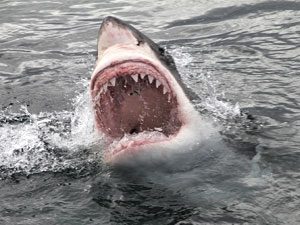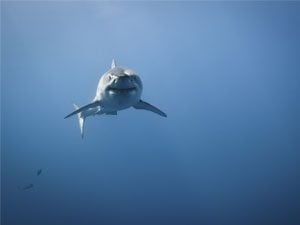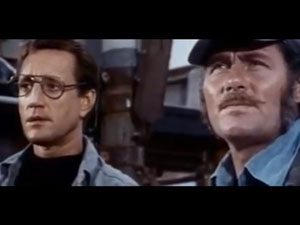Funny Movie Shark Attacks Small Boat of Pirate Team
Fascinating trivia to celebrate the 42nd anniversary of this classic summer thriller.
 On June 20, 1975, the now-iconic movie Jaws was released, igniting a nationwide terror of sharks that's still going strong 40 years later. The film also revolutionized the movie industry by inventing the idea of the summer blockbuster (back then, most highly anticipated movies were released around Christmastime). Jaws became the first motion picture to gross more than $100 million and won three Academy Awards (for Best Sound, Best Film Editing, and Best Original Dramatic Score).
On June 20, 1975, the now-iconic movie Jaws was released, igniting a nationwide terror of sharks that's still going strong 40 years later. The film also revolutionized the movie industry by inventing the idea of the summer blockbuster (back then, most highly anticipated movies were released around Christmastime). Jaws became the first motion picture to gross more than $100 million and won three Academy Awards (for Best Sound, Best Film Editing, and Best Original Dramatic Score).
Here, more fascinating Jaws trivia even film buffs might not know.
1. The movie Jaws was developed from a book of the same name by Peter Benchley. Though he says the book is pure fiction, Benchley says he was inspired by the capture of a 4,500-pound shark off the coast of Montauk in 1964.
2. Benchley originally titled the book Silence in the Deep before he asked his father, the children's books author Nathaniel Benchley, for suggestions. The senior Benchley sent back a list of 200 possible titles, including the now-famous monosyllabic title, and some lengthier options; for example, Wha's That Noshin' On My Laig? The title Jaws was the only one both Peter Benchley and his editors could agree upon.
3. Steven Spielberg, the film's director, first became aware of the book when he noticed it on top of a large stack of papers in his producer's office. He initially thought it was about a dentist.
4. Spielberg was not the original director chosen for the film. The first director was fired after a production meeting in which he continually referred to the shark as a whale.
5. Three months before production was set to begin, Spielberg decided he wanted to direct a different movie (he didn't want to be typecast as a "truck and shark" director). He went to speak with the producers, who knew he wanted to back out. When Spielberg saw that they had worn Jaws crew t-shirts, all three started laughing, and Spielberg said, "Never mind."
6. Benchley later became an ocean conservationist, and said he regretted writing a book that portrayed sharks in such a cold-blooded manner.
7. Producers knew they couldn't use a real great white shark in the movie because this breed died quickly in captivity; at the time, the current record for keeping a one alive in confinement was 11 days. Scientists believe that great whites died from depression and self-starvation due to the stress of capture.
8. Three mechanical sharks were constructed to play the part of the great white: a "left" and "right" shark for side shots, and a full-sized one.
9. Collectively, the sharks were referred to as Bruce—after Spielberg's lawyer.
10. After the full-sized shark sank during its first time in the water, the crew also nicknamed the shark "Flaws" or the "Great White Turd."
11. The sharks were to be attached to a 16-ton platform sitting on the ocean floor. The malfunctioning arm used to control the sharks was referred to as the "Iron Monster."
12. The mechanical sharks were such a disappointment, partly because their combined cost was $225,000 (nearly $1 million in today's currency).
13. The shark malfunction issues made it necessary to film most of the movie's scenes without them. In fact, the first shark doesn't appear until one hour and 21 minutes into the two-hour film.
14. In lieu of more face time with sharks, Spielberg says he channeled Alfred Hitchcock to let an invisible threat terrorize the audience.
15. Another filming roadblock: The odd-looking mechanized sharks attracted fellow mariners, who would often ruin a shot by steering over to ask what the production crew was doing. It would take up to six hours to set up shots again.
16. The original filming took place off the coast of Martha's Vineyard during May and June, but Spielberg had to extend the filming by three months because of shooting complications. A local prankster, apparently angered by the outsiders overstaying their welcome, left a dead brown shark on the porch of the production office.
17. Jaws was set to be released over the Christmas season, but Spielberg took so long filming that the movie had a summer release date, which was traditionally reserved for low-end movies. The filming delay is what spurred Jaws to become the first movie to define the concept of a "summer blockbuster."
18. The crew also lost 10 days of filming during the summer boating season. The first issue was the New York Yacht Club's Annual Cruise; boat after boat passed by on the supposed-to-be-empty horizon. This was followed by another parade of boats en route to the America's Cup race in Newport, Rhode Island.
19. The film's initial budget was $3.5 million, but it wound up costing around $8 million to make, the equivalent of $35 million in today's dollars. (Compare that with Pirates of the Caribbean's $341.8 million budget or Titanic's $294.3 million cost).
20. The production crew wasn't allowed to build sets for movie scenes on Martha's Vineyard, save for the set of Quint's boathouse. Town officials only gave their consent because the crew agreed to build on an abandoned lot, tear down after, and replace everything that had been there—including the pre-existing trash on the ground.

21. A real shark (not a great white) used in filming got tangled in rope and smashed the underwater cage, which contained a real actor for scale. Spielberg liked this footage so much, he decided to change the script and have Hooper, the out-of-town oceanographer, escape during this attack. None of it was planned.
22. The sharks used in the film were smaller than Spielberg wanted, so he hired a short actor specifically for those scenes.
23. Spielberg was not originally a fan of the film's now-iconic theme song. The first time he heard John William's opening track, he laughed at its simplicity. He later conceded that the music made the movie more thrilling.
24. In an early scene, a high school band is playing a Sousa march. The music was actually recorded by John Williams and his band, but according to Williams, many of the talented musicians found it difficult to play so poorly. Spielberg played the clarinet for the recording, which Williams said, "added just the right amateur quality to the piece."
25. Charlton Heston was considered for the role of Police Chief Martin Brody, but Spielberg decided to go with a less-known actor because he didn't want the audience to immediately identify Brody as the heroic savior (based on Heston's previous film roles). Heston reportedly refused to ever work with the director.
26. Roy Scheider, the actor who did get the leading role, happened upon it by coincidence. At a party, he heard Spielberg describing the scene where the shark leaps up onto the boat, and immediately asked for a role in the film.

27. Scheider improvised the now-famous line, "You're going to need a bigger boat."
28. The name of the production company Bad Hat Harry, which has produced such movies as X-Men and Superman Returns, was inspired by a scene in Jaws. Chief Brody tells a beachgoer that he has an ugly swimming cap: "That's some bad hat, Harry!"
29. Jaws book author Peter Benchley makes a cameo in the film as a newspaper reporter; he worked at the Washington Post before penning Jaws.
30. Townspeople of Martha's Vineyard were paid $64 each for playing extras who ran across the beach and screamed during the shark attack scene.
31. The beachgoers in the Fourth of July scene didn't need much prodding to get them out of the water when the supposed shark attack occurred: The ocean temperature that June day was a frigid 64 degrees.
32. Cameraman Bill Butler invented a "water box" with glass windows that allowed cameras to be submerged because Spielberg wanted the audience to feel like they were about to drown in the ocean.
33. Jaws was initially given an R rating before a graphic scene involving a severed leg was cut from the film. The rating was readjusted to PG (there was no PG-13 rating at the time).
34. Artist Roger Kastel originally designed the film's iconic poster. The swimmer in the poster was a model he was sketching for an ad in Good Housekeeping; he asked her to stay a little longer and lie on a stool in a swimming position.
35. While the mechanical sharks were destroyed after filming, the Orca—the film's famous boat—ended up at Universal Studios in Hollywood. Steven Spielberg would often visit the boat and reminisce about the movie that launched his career.
36. One day in 1996 when Spielberg went to visit the Orca, he discovered it had disappeared. According to Spielberg, a Universal Studios employee had decided to chop up the mildewed and termite-infested boat. All that remains now is the steering wheel, a propeller, and the anchor.
37. In the movie's original ending, the shark anticlimactically dies from blood loss while circling Brody. Spielberg changed this to the famous explosion scene, but not everyone agreed with his decision. Peter Benchley was kicked off the set after protesting the change to his novel. He later conceded that Spielberg had made the right decision.
38. But Spielberg didn't direct the infamous explosion scene. Exhausted from shooting, he had already returned to Hollywood to work on post-production, leaving the filming to the secondary crew.
39. Spielberg would later say: "Jaws was my Vietnam. It was basically naïve people against nature, and nature beat us every day."
40. Among the movie's biggest fans was Fidel Castro, who reportedly interpreted the shark attacks as symbolic of an attack on American capitalism.
Source: https://www.rd.com/article/jaws-movie-trivia-facts/
0 Response to "Funny Movie Shark Attacks Small Boat of Pirate Team"
Post a Comment